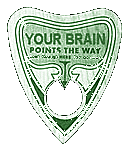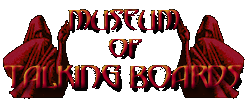

 Want to contact a spirit with your Ouija
board? How about contacting your inner spirit? The
human-potential movement has offered up a novel role for
the Ouija apart from the commonly recognized spiritual one.
It involves a therapeutic technique called ideomotor
or psychomotor questioning, and with the aid of the
Ouija board, you can use it to explore your inner psyche or
subconscious mind. The subconscious mind is the
place, not normally accessible to us, where we store our
secret fears, anxieties, and our concerns about ourselves
and the world around us. Query the subconscious properly
using this method, and you can identify hidden difficulties
that are inhibiting you plus attain a new sense of clarity
and insight in the bargain. You can root out inner
emotional barriers to personal growth and take steps to
effectively deal with them. Or, so advocates of this
particular technique tell us.
Want to contact a spirit with your Ouija
board? How about contacting your inner spirit? The
human-potential movement has offered up a novel role for
the Ouija apart from the commonly recognized spiritual one.
It involves a therapeutic technique called ideomotor
or psychomotor questioning, and with the aid of the
Ouija board, you can use it to explore your inner psyche or
subconscious mind. The subconscious mind is the
place, not normally accessible to us, where we store our
secret fears, anxieties, and our concerns about ourselves
and the world around us. Query the subconscious properly
using this method, and you can identify hidden difficulties
that are inhibiting you plus attain a new sense of clarity
and insight in the bargain. You can root out inner
emotional barriers to personal growth and take steps to
effectively deal with them. Or, so advocates of this
particular technique tell us.
Whether you accept the existence of an actual subconscious mind, or think of it simply as a term to describe that level just below conscious awareness, there is something that you will quickly discover: responses using ideomotor questioning can be startling and surprisingly revealing. Non-believers who might not have much use for a spiritual tool may now find the Ouija board quite helpful indeed. And those of you who don't appreciate psychobabble mumbo jumbo about "subconscious minds" just might find it helpful, also. Think of it instead as a fun mental exercise—like a crossword puzzle, only without the cross and without the puzzle. Writing a self-improvement page was not exactly what we had in mind for the Museum of Talking Boards. Still, the use of the Ouija board in this unconventional manner was not something we wanted to overlook.
Tapping the Subconscious Mind
 You may wonder if this is safe. Couldn't it
be dangerous, releasing all these secret inner demons?
Might it make you crazy? Perhaps send you out screaming
into the night? The answer is no; it is quite safe. You
will not inadvertently short-circuit your brain. You may
get annoyed at yourself when you realize that you are
unnecessarily obsessing about something in your life, but
then that is why we call it "insight." That is the key to
change. If you don't want to change, well, that's a choice,
too. At least the problem is out in the open and you are
free to deal with it, or not—as you see fit.
You may wonder if this is safe. Couldn't it
be dangerous, releasing all these secret inner demons?
Might it make you crazy? Perhaps send you out screaming
into the night? The answer is no; it is quite safe. You
will not inadvertently short-circuit your brain. You may
get annoyed at yourself when you realize that you are
unnecessarily obsessing about something in your life, but
then that is why we call it "insight." That is the key to
change. If you don't want to change, well, that's a choice,
too. At least the problem is out in the open and you are
free to deal with it, or not—as you see fit.
As to resolving a particularly difficult problem that that emerges during therapeutic automatism, that can be a study in itself. The simple knowledge that a problem exists may not bring to mind an instant solution. It may be more complex than that. If you are struggling with an issue too large to handle, take our advice and consult a professional counselor or therapist. Don't knock yourself out over it.
Methods of Questioning
 Several techniques for questioning the
subconscious mind have been in use for some time. The two
most popular are the pendulum, and the finger response
method. They are pretty primitive compared to the Ouija
board. The pendulum is a simple weight on a string held
over a message board marked with three to six word choices.
The finger response method uses fingers to represent "Yes,"
"No," and "Don't want to answer." Some creative individuals
have developed the finger response method to high art by
incorporating all ten fingers, but we have to tell you,
this is not something you want to try to learn. These
techniques leave a lot to be desired. If you are curious to
know how well they work, try talking to someone using three
to six words tomorrow and see how far you get. It's easy to
see why ideomotor questioning isn't exactly the hot topic
among psychotherapists.
Several techniques for questioning the
subconscious mind have been in use for some time. The two
most popular are the pendulum, and the finger response
method. They are pretty primitive compared to the Ouija
board. The pendulum is a simple weight on a string held
over a message board marked with three to six word choices.
The finger response method uses fingers to represent "Yes,"
"No," and "Don't want to answer." Some creative individuals
have developed the finger response method to high art by
incorporating all ten fingers, but we have to tell you,
this is not something you want to try to learn. These
techniques leave a lot to be desired. If you are curious to
know how well they work, try talking to someone using three
to six words tomorrow and see how far you get. It's easy to
see why ideomotor questioning isn't exactly the hot topic
among psychotherapists.
Ouija boards, like those made by Hasbro, work much better for obvious reasons. In addition to the letter and number choices, you can customize your board with key words to really speed things up. Our favorite board to use is the Ziriya Message Board produced in the seventies. With the Ziriya, you can string words and ideas together so quickly that it feels absolutely supernatural. You may want to make your own board patterned after it, if you find the Ouija too slow for your liking.
Using the Board, Suspension of Disbelief, and Zamfarpotec
 The directions for
using the Ouija for therapeutic automatism are the same as
if you were using it in the conventional manner. Choose a
quiet place free from distractions and noise. Position
yourself comfortably with the board on your lap and try to
free your mind of conscious thought. Although you realize
that you will be contacting your "self" instead of a
"spirit" try to imagine your "self" as an entity apart, as
if it were a being separate from yourself. This is an
important concept. In order for you to be in contact with
your subconscious, there must be a "suspension of
disbelief" on the part of your conscious self. Act, pretend
and use your imagination to achieve this detachment. You
may find disassociation from your subconscious mind easier
if you address it with a friendly nickname like "Bill" or
"Susan" or "Zamfarpotec" (your
inner Aztec warrior).
The directions for
using the Ouija for therapeutic automatism are the same as
if you were using it in the conventional manner. Choose a
quiet place free from distractions and noise. Position
yourself comfortably with the board on your lap and try to
free your mind of conscious thought. Although you realize
that you will be contacting your "self" instead of a
"spirit" try to imagine your "self" as an entity apart, as
if it were a being separate from yourself. This is an
important concept. In order for you to be in contact with
your subconscious, there must be a "suspension of
disbelief" on the part of your conscious self. Act, pretend
and use your imagination to achieve this detachment. You
may find disassociation from your subconscious mind easier
if you address it with a friendly nickname like "Bill" or
"Susan" or "Zamfarpotec" (your
inner Aztec warrior).
FIGs, FIBs and FEELS RIGHTs
Normally, when working with the Ouija, you would ask, "Hello, is anyone there?" This isn't exactly the appropriate question for your subconscious mind for obvious reasons. So instead you might start with, "What's up, Zamfarpotec?" or "What are you thinking about today?" and take it from there. Begin by slowly circling the board with the message indicator. Relax as you move from letter to letter. Imagine the message indicator taking directions from another, apart from yourself. Stop at a letter when you get a FEELS RIGHT. A FEELS RIGHT is a term for the instinctive feeling that the message is correct. You know it is right because it "feels right."
Try not to be too specific with your questions in the beginning and let your subconscious lead you in the direction it wants to go. Like dreams, the responses you first get may seem disjointed or nonsensical but with persistence will begin to have meaning. There will be plenty of room for interpretation and you will know intuitively when you are on track.
Once your subconscious has released a particular thought or "FIG" (short for "figment") through the board, you will want to address the idea more completely. Knowing the right questions to ask will speed up the process considerably. Be very specific in your questioning at this point, and don't be surprised if the responses you get take you down an unexpected path. FIGs may have multiple meanings or may mean something you don't suspect. For example, let's say that the board returns the FIG: "u overboard." This may mean that you secretly fear that you are spending too much (you're overboard) on things that you don't really need. On the other hand it may mean that you are worrying about paying the rent (you're worried over board), which would logically follow if your spending is out of control. But it also may signal fears concerning your flaky roommate who is consistently late paying his part of the rent. What else might "u overboard" mean? How about "you're over bored?" This may mean that you are in a particularly stagnant period in your life and secretly desire a change. The proper questioning technique will uncover these differences. Use the "YES" and the "NO" on the board to simplify answering. For instance, to the FIG "u overboard," you might ask, "Am I doing something to excess?" The board would answer "YES" or "NO." You wouldn't ask, "What the heck does 'overboard' mean?" unless you want Zamfarpotec to wear you out with a long, drawn out explanation.
Occasionally you may get a FIB. A FIB (fib or lie) is a message that couldn't possibly be true. If your subconscious tells you, for instance, that your girlfriend is from the planet Mars, you may have the sneaking suspicion that it is being less than truthful. The real meaning may be that your girlfriend is so incomprehensible that it seems as if she is from the planet Mars. Be careful how you interpret a FIB since the subconscious sometimes responds figuratively rather than literally. But what if you don't even have a girlfriend? Sometimes you will get messages that are way off the mark and just unbelievable. There are a variety of reasons why this is so and we won't go into them here except to say that a FIB can be the subconscious Ouija equivalent of "conditions bad; try again later." If you suspect that you are getting bogus information and are having trouble distinguishing a FIB from a FIG, get a reality check from someone whose opinion you trust, or a qualified counselor. Most of the time you can dispense with a FIB by clarifying the response, as we did in the "Mars" example, or by changing the subject line of your questioning.
Couples Therapy
Therapeutic automatism with the Ouija board works well for couples also. The Ouija board can do a fine job of cutting through barriers normally erected to avoid conflict—not a bad thing if a couple is truly interested in understanding one another. It can be particularly useful in rooting out areas of disharmony and can offer up issues that partners may be reluctant to share. A warning: tread carefully here. Sensitivity on the part of both users is vital. Issues steaming below the surface can bubble up suddenly during a session, so understand before starting that things may get a little dicey. Have an agreement to stop should things become too intense. Should either partner start to blame or become uncomfortable with a subject, the session must immediately end. And, do we need to say it? Resolve serious problems with the aid of a trained professional, not the Ouija board.
As when working alone, let the Ouija board do the work. The directions for using a Ouija board together are the same whether you are addressing your inner selves or your outer spirits. Do not consciously push the message indicator to the letters. The two of you should treat your inner spirits as separate entities. It is important that you not forget this.
|
Points to Remember
|
